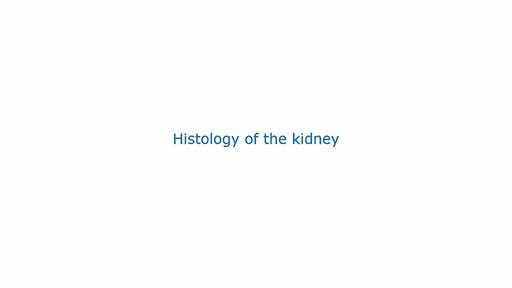2.5 Histology of the kidney
As the anatomy and histology of the kidney is quite complex, this video gives you a short tour of the section, before you look at it yourself in the virtual microscope.
Download this video clip.Video player: 39444_ou_futurelearn_mc1008_vid_013-540.mp4


Transcript
DAVID MALE
Histology of the kidney. In this video, I'll be taking you on a short histological tour of the kidney, pointing out some of the parts of the nephron, a structure that philtres the blood and ultimately produces urine.
Here's a diagram of a nephron. Each nephron acts as a urine producing unit. And there are many thousands of them in a single kidney. The blood is initially filtered in the capillaries of the Bowman's capsule. It's located in the cortex of the kidney-- the outer layer. The filtrate first enters the proximal convoluted tubules and then passes down into the loop of Henle in the medulla before returning to the distal convoluted tubules in the cortex.
As it passes through the nephron, some salts and small molecules and water are reabsorbed, while other salts and small molecules may be secreted into the tubules for excretion. The processed filtrate, which is now urine, finally passes into the medullary collecting ducts and enters the renal pelvis.
The kidney section in the virtual microscope includes the cortex-- the outer region of the kidney-- and some parts of the medulla are also visible in the section. The appearance under the microscope is not nearly as neat as this diagram. Let's take a look.
The kidney is slide 9 in the week 3 set. And I have already loaded it onto the microscope stage. It shows a section which extends from the capsule of the kidney at the right hand end of the section. And it includes the full depth of the cortex and part of the medulla, starting about here.
Let's look first for a Bowman's capsule. There are two nice examples here. I've got to switch to the times 10 objective. Let's look first at this Bowman's capsule. The tuft of capillaries, the glomerulus, is in the centre of the capsule. And it's supplied with blood by the renal arterioles, which enter here. In this example, it is possible to see how the arterioles enter the capsule, but that is not always the case. It depends on where the section runs through the capsule.
Also visible here is the juxtaglomerular apparatus, which regulates renal blood flow and the glomerular filtration rate. The epithelial cells lining the Bowman's capsule are also very visible, although it's difficult in this instance to see where the capsule opens into the proximal convoluted tubules, usually on the opposite side to where the blood vessels enter.
If I now move to the outer part of the cortex, you can see two different sorts of tubules. The proximal tubules have thicker walls and a smaller lumen, while the distal tubules have thinner walls and a more obvious lumen.
Also visible in this section are some capillaries with flattened endothelial cells. Erythrocytes can help to identify blood vessels, but in this case, the organ was perfused to remove blood before sectioning, so you won't see them here.
Finally, I'm going to look at the medulla. I will switch back to the times 4 objective. And, now, as I move towards the medulla, you can start to see the loops of Henle becoming more apparent. I'll go to the times 10 objective so that you can see them a little better. They're interspersed with, and run parallel with, the medullary collecting ducts. So it can be difficult to distinguish them. But the ducts are lined with clear-celled cuboidal epithelium, while the epithelium on the loops of Henle is usually more flattened.
I'll move down towards the bottom of the section here and you can start to see some of the medullary collecting ducts. You may also see some blood vessels in the tissue. There is an example of a venule up here.
It's worth taking some time to look at the different structures of the normal kidney, each one performing its own function in the production of urine and the overall function of excretion.
Interactive feature not available in single page view (see it in standard view).
Activity 5
Open the virtual microscope [Tip: hold Ctrl and click a link to open it in a new tab. (Hide tip)] in a new window or tab. Find Slide 9 in the ‘Week 3’ category.
Now it’s your turn to identify the main areas that exist within the kidney sample shown in Slide 9. Try to locate each of the following:
- the glomerulus
- Bowman’s capsule
- convoluted tubules
- the loop of Henle
- collecting tubules.
